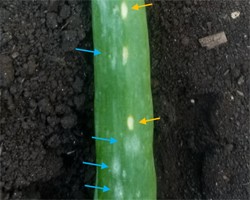Know the Difference: Botrytis Leaf Blight Halo Lesions vs BLB Necrotic Spots
Christy Hoepting, Extension Vegetable Specialist
Cornell Vegetable Program

Through recent on-farm fungicide trials, we've determined that not all Botrytis leaf blight (BLB) lesions are controlled equally. There are two kinds of BLB lesions: BLB halo lesions and BLB necrotic spots and your best fungicide options for control of Botrytis leaf blight depends on what kind of spot you got! See Know the Difference: Botrytis Leaf Blight Halo Lesions vs BLB Necrotic Spots for photos.
BLB Halo LesionsWhen BLB first occurs in June and early July, the lesions appear as a tiny yellow necrotic spot surrounded by a silvery halo. It is also common for the necrotic spot to be absent leaving just a silvery spot (Fig. 1). When BLB halo lesions get old, the center becomes sunken and often splits; it is still yellowish in color and remnants of the silvery halo can usually still be seen (Fig. 2).
See Scouting Onions for Botrytis Leaf Blight Halo Lesions for more more information and photos.
During the second half of July, BLB lesions often do not have the silvery halo. Instead, they are yellow spots, sometimes yellowish-white spots as they get bigger, with a round defined border, that are pin-prick to 1 mm or slightly larger in size (= BLB necrotic spots) (Fig. 1 and Fig. 3). By August, BLB necrotic spots are often dominant, while BLB halo lesions decline, especially in Elba muck. BLB halo lesions tend to linger for the duration of the season in Wayne and Oswego muck-onion growing regions, although both do occur.
BLB necrotic spots are not to be confused with old BLB halo lesions where the initial necrotic spot becomes sunken and often split (Fig. 2). BLB necrotic spots could also be confused with contact herbicide injury.
Know the Difference: Botrytis Leaf Blight Halo Lesions vs BLB Necrotic Spots (pdf; 264KB)

Upcoming Events
Vegetable Pest and Cultural Management Field Meeting for Auction Growers -- Ontario Produce Auction
July 15, 2025
Stanley, NY
This evening meeting will demonstrate pest management in fresh market vegetables in both field and greenhouse (high tunnel) vegetables, primarily for those growing for wholesale auction. A hands-on demonstration of weed, insect and disease identification in vegetables including management options. Details on each topic will focus on field observations at the farm.
Orleans Summer Vegetable Meeting, 2025
July 16, 2025
Waterport, NY
Meeting themes are pest management in a wide array of produce and best practices for pesticide use. Professor Brian Nault will cover allium leaf miner and thrips in onions, garlic, and leeks, and discuss insect challenges in other crops. Bring your questions! We'll also have a field walk that includes high tunnel tomato and cucumber.
DEC credits available: 0.5 in CORE plus either 1.25 in 1a and 23, or 0.75 in 24.
Vegetable Pest and Cultural Management Field Meeting for Auction Growers -- Finger Lakes Produce Auction
July 18, 2025
Penn Yan, NY
This evening meeting will demonstrate pest management in fresh market vegetables in both field and greenhouse (high tunnel) vegetables, primarily for those growing for wholesale auction. A hands-on demonstration of weed, insect and disease identification in vegetables including management options. Details on each topic will focus on field observations at the farm.


































